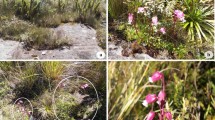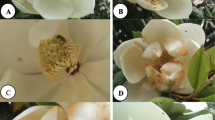Abstract
The presence of neuter ray florets in species within Asteraceae is generally believed to increase pollinator attraction. In the endemic Galápagos genus Scalesia (Asteraceae) a natural variation in the presence/absence of neuter ray florets is found. To evaluate whether the presence of ray florets plays a selective role on female reproductive success we chose two species of Scalesia, Scalesia affinis that carries ray florets and S. pedunculata that is rayless. On Santa Cruz Island capitula of S. pedunculata were equipped with fake ray florets while others were untouched. On Isabela Island ray florets were removed on half of the capitula of S. affinis. In S. affinis rayed capitula received more pollinators and more pollen, which resulted in a significantly higher embryo production. In S. pedunculata no effect on embryo production was found. The disagreement between the two species may correspond to a difference in visitation frequency, S. pedunculata receiving many more visit than S. affinis. Thus, ray floret development proved beneficial in pollinator-restricted localities.
Similar content being viewed by others
References
Andersson, S. (1991) Floral display and pollination success in Achillea ptarmica (Asteraceae). Holarc. Ecol. 14, 186–191.
Andersson, S. (1996) Floral display and pollination success in Senecio jacobaea (Asteraceae): interactive effects of head and corymb size. Am. J. Bot. 83, 71–75.
Andersson, S. (1999) The cost of floral attractants in Achillea ptarmica (Asteraceae): Evidence from a ray removal experiment. Plant Biol. 1, 569–572.
Bell, G. (1985) On the function of flowers. Proc. Roy. Soc. Lond. B 224, 223–265.
Broyles, S.B. and Wyatt, R. (1995) A reexamination of the pollen-donation hypothesis in an experimental population of Asclepias exaltata. Evolution 49, 89–99.
De Nettancourt, D. (1977) Incompatibility in Angiosperms. Springer Verlag, Berlin.
Devlin, B., Clegg, J. and Ellstrand, N.C. (1992) The effect of flower production on male reproductive success in wild radish populations. Evolution 46, 1030–1042.
Eliasson, U. (1974) Studies in Galápagos Plants XIV. The Genus Scalesia Arn. Opera Botanica 36, 1–117.
Fryxell, P.A. (1957) Mode of reproduction of higher plants. The Bot. Rev. 23, 135–233.
Herrera, C.M. (1996) Floral traits and plant adaptation to insect pollinators: a devils advocate approach. In D.G. Lloyd and S.C.H. Barrett, (eds) Floral Biology. Chapman & Hall, New York, pp. 65–87.
Ingram, R. and Taylor, L. (1982) The genetic control of a non-radiate condition in Senecio squalidus L. and some observations on the role of ray florets in the Compositae. New Phytol. 91, 749–756.
Koch, M.F. (1930) Studies in the anatomy and morphology of the Compositae flower II. The corollas of the Heliantheae and Mutisieae. Am. J. Bot. 17, 995–1010.
Lack, A.J. (1982) Competition for pollinators in the ecology of Centaurea scabiosa L. and Centaurea nigra L. III. Insect visits and the number of successful pollinations. New Phytol. 91, 321–339.
Linsley, E.G. (1966) Pollinating insects of the Galápagos Islands. In R.I. Bowman (ed.) The Galápagos. University of California Press, Berkeley. pp. 225–232.
Mani, M.S. and Saravanan, J.M. (1999) Pollination Ecology and Evolution in Compositae (Asteraceae). Science Publishers Inc, New Hampshire.
Manly, B.F.J. (1985) The Statistics of Natural Selection. Chapman and Hall, London.
McMullen, C.K. (1989) The Galapagos carpenter bee, just how important is it? Noticias de Galápagos, 48, 16–18.
McMullen, C.K. and Naranjo, S.J. (1994) Pollination of Scalesia baurii ssp. hopkinsii (Asteraceae) on Pinta Island. Noticias de Galápagos, 53, 25–28.
Nielsen, L.R., Philipp, M., Adsersen, H. and Siegismund, H.R. (2000) Breeding system of Scalesia divisa Andersson, an endemic Asteraceae from the Galápagos Islands. Det Norske Videnskaps-Akademi. I. Mat.-Naturv. Klasse, Skrifter, Ny Serie 39, 127–138.
Olsen, K.M. (1997) Pollination effectiveness and pollinator importance in a population of Heterotheca subaxillaris (Asteraceae). Oecologia 109, 114–121.
Panero, J.L. (1992) Systematics of Pappobolus (Asteraceae-Heliantheae). Syst. Bot. Monog. 36, 1–195.
Philipp, M. and Hansen, T. (2000) The influence of plant and corolla size on pollen deposition and seed set in Geranium sanguineum (Geraniaceae). Nord. J. Bot. 20, 129–140.
Proctor, M., Yeo, P. and Lack, A. (1996) The Natural History of Pollination. Timber Press, Portland, Oregon.
SAS. (1989) SAS/STAT User's Guide, Version 6, 4th edn, Vol 2, SAS Institute, Cary, NC.
Schilling, E.E., Panero, J.L. and Eliasson, U.H. (1994) Evidence from chloroplast DNA restriction site analysis on the relationships of Scalesia (Asteraceae: Heliantheae). Am. J. Bot. 81, 248–254.
Sokal, R.R. and Rohlf, F.J. (1981) Biometry. 2nd edn. W.H. Freeman and Company, San Francisco.
Spring, O., Heil, N. and Eliasson, U. (1999) Chemosystematic studies on the genus Scalesia (Asteraceae). Biochem. Syst. Ecol. 27, 277–288.
Stuessy, T.F, Spooner, D.M. and Evans, K.A. (1986) Adaptive significance of ray corollas in Helianthus grosseserratus (Compositae) Am. Midl. Nat. 115, 191–197.
Wiggins, I.L. and Porter, D.M. (1971) Flora of the Galápagos Islands. Stanford University Press, Standard.
Author information
Authors and Affiliations
Corresponding author
Rights and permissions
About this article
Cite this article
Nielsen, L.R., Philipp, M. & Siegismund, H.R. Selective advantage of ray florets in Scalesia affinis and S. pedunculata (Asteraceae), two endemic species from the Galápagos. Evolutionary Ecology 16, 139–153 (2002). https://doi.org/10.1023/A:1016301027929
Issue Date:
DOI: https://doi.org/10.1023/A:1016301027929




